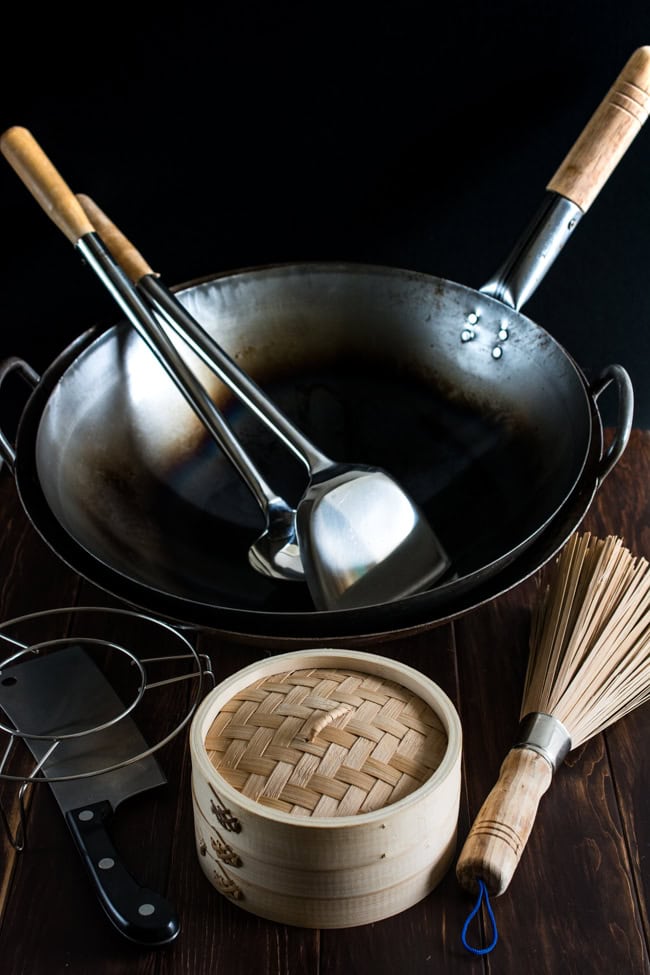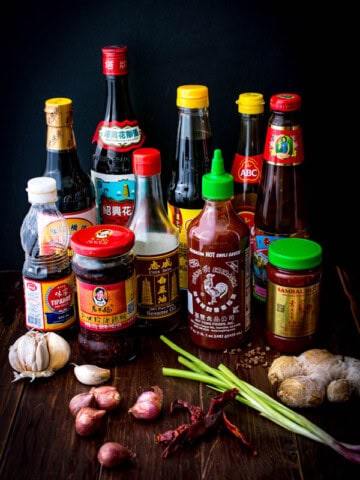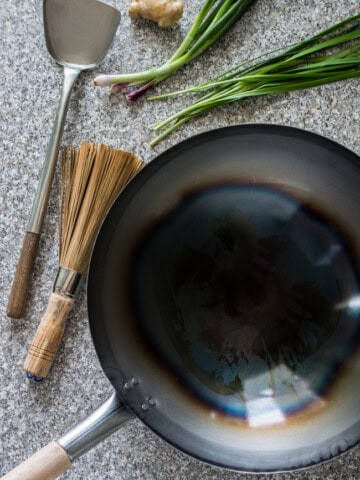My list of Top 10 "Must-Have" kitchen items for Asian cooking.

While you can use regular pots and pans for most Asian cooking, having the right tools can make it much easier and more enjoyable, especially if you cook Asian dishes frequently.
There's no need to purchase all these items at one go. Start with the essentials - just a good wok and a wok spatula is a fantastic starting point. You can build up your collection of Asian kitchen essentials over time.
Looking to stock up your Asian Pantry as well? Check out my list of Asian Pantry Essentials!
1. Carbon Steel Wok or Cast Iron Wok
The wok will be one of the most versatile tools in your kitchen. You can stir-fry, roast, steam, boil, pan-fry and braise foods in your wok. Once properly seasoned, it will be naturally “non-stick”.
It’s almost impossible to replicate certain Chinese dishes using a regular non-stick pan because the wok can withstand much higher temperatures than a non-stick pan; and most stir-fry dishes call for very high heat.
There are woks made from different materials such as aluminum, stainless steel, non-stick (with Teflon), etc, but I highly recommend sticking with carbon steel (which I personally love - it is thankfully usually the least expensive option, too!) or cast iron.
If your wok has a flat base, you’ll be able to use it on your electric or glass-top stove; but if you have a traditional wok with a round base, you will need a wok ring to hold the wok in place over the burner.
Your brand new wok will need to be seasoned before its first use (and may need to be re-seasoned from time to time). Click HERE for a step-by-step guide on How to Season Your Wok.
2. Wok Spatula and Ladle
A wok goes hand-in-hand with a wok spatula while the ladle comes in handy for soups and sauces.
Find a wok spatula and ladle with a wooden handle. The ones with stainless steel handles look attractive but I don't recommend them as they conduct heat very well and if you tend to leave your spatula in your wok while cooking over high heat (which I frequently do), the handle will get hot quickly.
Also, your fingers may get a bit greasy and oily while cooking and when you touch the smooth stainless steel handle, it will cause your grip to be slippery.
Just as steel wok spatulas should never be used on a non-stick surface, bamboo, silicone and wooden spatulas should not be used in a carbon steel or cast iron wok as they won't be able to properly pick up all of the food from the bottom of the wok.
Steel wok spatula's are slightly curved at the end so that it can glide against the bottom of your curved wok to pick up every last bit of food, even sauces!
3. Wok Lid
A wok lid paired with a metal steaming rack enables you to steam foods in your wok. You can also use the wok lid to braise meats in your wok. Keep this lid on your wok when you store it so that dust does not settle on the surface. Most wok lids are made of aluminum so they tend to be very light.
A wok lid paired with a metal steaming rack enables you to steam foods in your wok. You can also use the wok lid to braise meats in your wok. Keep this lid on your wok when you store it so that dust does not settle on the surface. Most wok lids are made of aluminum so they tend to be very light.
4. Bamboo Wok Brush
A wok brush is all you will need to clean your wok. You can also use a stainless steel scrubber in place of a wok brush to clean your wok.
Simply rinse the wok under running tap water, then move your wok brush in a circular motion to remove any food residue that may be stuck on the wok surface, then place the wok back on the burner over medium-high heat to allow it to dry.
Limit the use of soap as much as possible, as it will remove the oils that are very much needed to season your wok and give it that nice patina over time.
5. Bamboo Skimmer/Spider Skimmer
Would you like to save this?
A bamboo skimmer (also known as a "spider skimmer") comes in really handy when deep-frying or blanching food in your wok. You can pick up much more food with a skimmer as opposed to using your wok spatula.
You can find skimmers in a variety of sizes. Larger skimmers are great for blanching vegetables and noodles, while the smaller skimmers are easier to use when deep-frying.
6. Deep Fry Rack
Deep-frying will no longer be a chore with a deep-fry rack. This rack hangs on the inside of your wok. You don’t have to hold the food against the side of the wok to wait for the excess oil to drain.
You can just pick it right up with your wok spatula or bamboo skimmer, and transfer it straight to your deep-fry rack. The excess oil will simply fall back into the wok.
7. Electric Rice Cooker
Rice is THE main staple in Asian cuisine. Yes, you could cook rice on a stove top but an electric rice cooker makes it SO much more convenient. Simply fill the rice cooker with the rinsed uncooked rice, fill it with water to the level marked, and turn it on.
Perfect rice every time! No more burnt, undercooked, or mushy rice. In addition, you could prepare the rice ahead of time and use the "keep warm" function to keep the rice warm for hours!
BONUS: you can also cook full meals in your rice cooker! Click here for my Rice Cooker Hainanese Chicken Rice recipe!
8. Bamboo Steamers
Bamboo steamers are famously used for dim sum but you can steam just about anything that you can fit into the steamer. Simply boil some water in your wok and place the bamboo steamer right over it (make sure you leave about a couple of inches between the boiling water and the steamer).
Use Bamboo Steamer Liners for quick and easy clean-up!
9. Chinese Cleaver
A cleaver may look intimidating but I know you'll grow to love it. It is especially useful for cutting meats like chicken, and even pork ribs! Most Chinese dishes with pork ribs usually require that it be cut into little pieces and a cleaver can do this job easily.
If you find a cleaver intimidating, a good chef's knife will do (however, please ask your butcher to cut your pork ribs for you; don't attempt that with a chef's knife!)
10. Mortar and Pestle
A mortar and pestle are used to grind spices, make pastes, etc. I love to use it to mince garlic and to make sambal (ground chilies). Some flavors just can’t be replicated using a food processor.
Equip your kitchen with these top 10 Asian kitchen essentials to transform your cooking experience. Feel free to contact me if you have any questions or need further recommendations. Happy cooking!













chefintheburbs says
Great list! Do you have any tips for cleaning the mortar? How do you get spices out of the little holes?
Char says
Thanks so much, Shelley! For the granite mortar, I've always just used a bit of soap and warm water. Just don't let it soak in soapy water; rinse it off quickly.
Gary Fowler says
My wife bought me an aluminum one that is Teflon coated but I think the high heat needed for Chinese cooking will melt the plastic utensils normally used for Teflon coated pans.
What utensil do you use on a Teflon coated wok?
Char says
Hi, Gary! I would recommend using a bamboo or wooden spatula with the Teflon wok. However, I would highly recommend a carbon steel wok instead of Teflon coated if at all possible. Teflon tends to releases toxins above a certain temperature so it is not suitable for high-heat wok cooking.